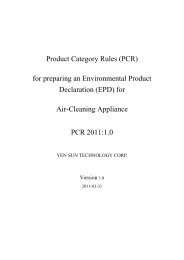Download(PDF) - PCR Library
Download(PDF) - PCR Library
Download(PDF) - PCR Library
You also want an ePaper? Increase the reach of your titles
YUMPU automatically turns print PDFs into web optimized ePapers that Google loves.
Annex B (reference): Collection of fuel consumption data and calculation of GHG emissions for truck<br />
transport<br />
B.1 Fuel consumption method<br />
B.1.1 Collect data on fuel consumption for each transport mean, and convert the unit of fuel consumption from “L”<br />
to “kg”.<br />
Fuel consumption (kg) = Fuel consumption (L) x Fuel density (kg/L)<br />
- Fuel density of gasoline= 0.75kg/L<br />
- Fuel density of light oil= 0.83kg/L<br />
B.1.2 Calculate GHG emissions by multiplying fuel consumption (kg) by secondary data for each type of fuel.<br />
B.2 Fuel cost method<br />
B.2.1 Collect data on fuel cost (km/L) and transport distance (km) for each transport mean, and calculate fuel<br />
consumption by using the following equation.<br />
Fuel consumption (kg) = [Transport distance (km) / Fuel efficiency (km/L)] x fuel density (kg/L)<br />
- Fuel density of gasoline= 0.75kg/L<br />
- Fuel density of light oil= 0.83kg/L<br />
B.2.2 Calculate GHG emissions by multiplying fuel consumption (kg) by secondary data for each type of fuel.<br />
B.3 Ton-kilometer method<br />
B.3.1 Calculate fuel consumption per freight transport amount following the formula "a)" or "b)"below.<br />
a) In the case of truck using gasoline as fuel:<br />
ln x = 2.67 0.927 ln (y/100) 0.648 ln z<br />
x: Fuel consumption per freight transport amount (1/t-km)<br />
y: Loading ratio (%)<br />
z: Maximum loading capacity of truck (kg)<br />
b) In the case of truck using light oil as fuel:<br />
ln x = 2.71 0.812 ln (y/100) 0.654 ln z<br />
x: Fuel consumption per freight transport amount (L/t-km)<br />
y: Loading ratio (%)<br />
z: Maximum loading capacity of truck (kg)<br />
B.3.2 Calculate GHG emissions by multiplying fuel consumption (kg) by secondary data for each type of fuel.<br />
-14-















